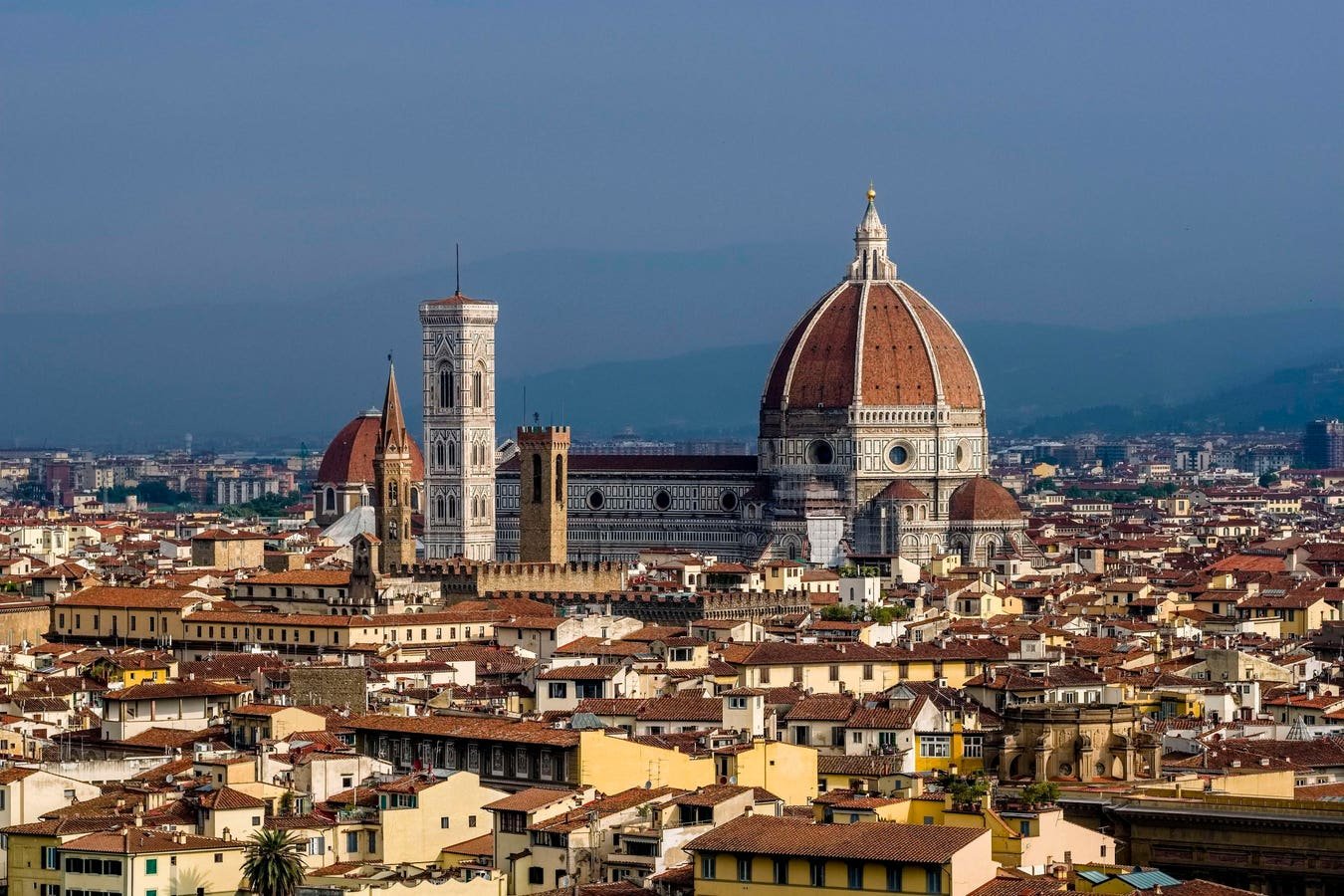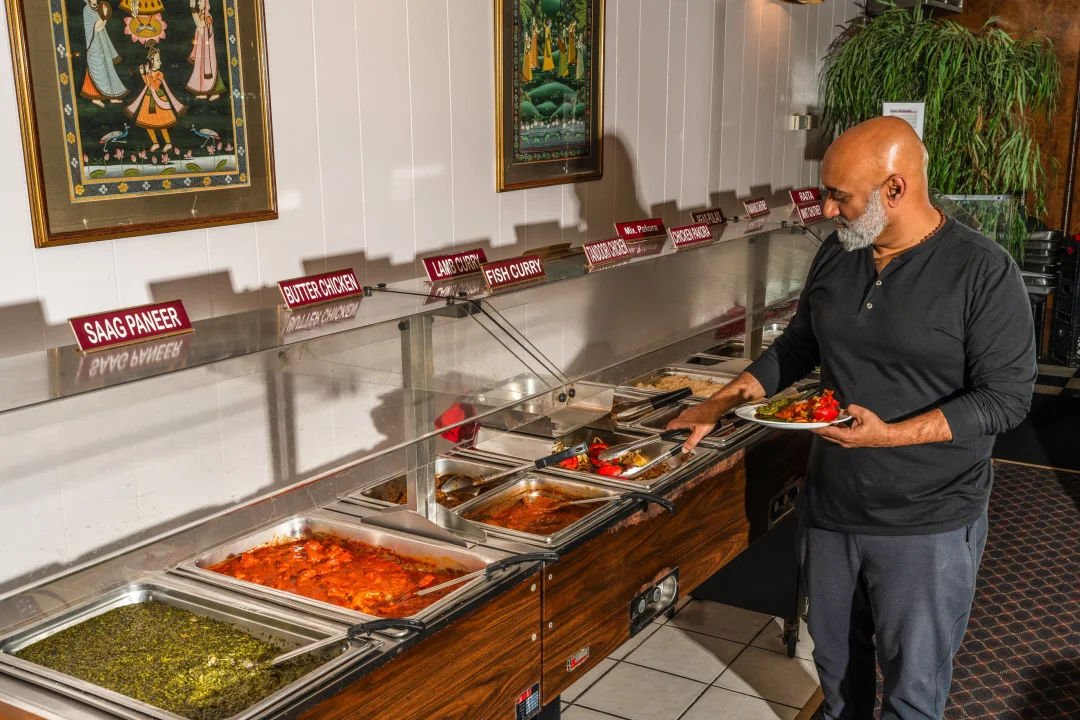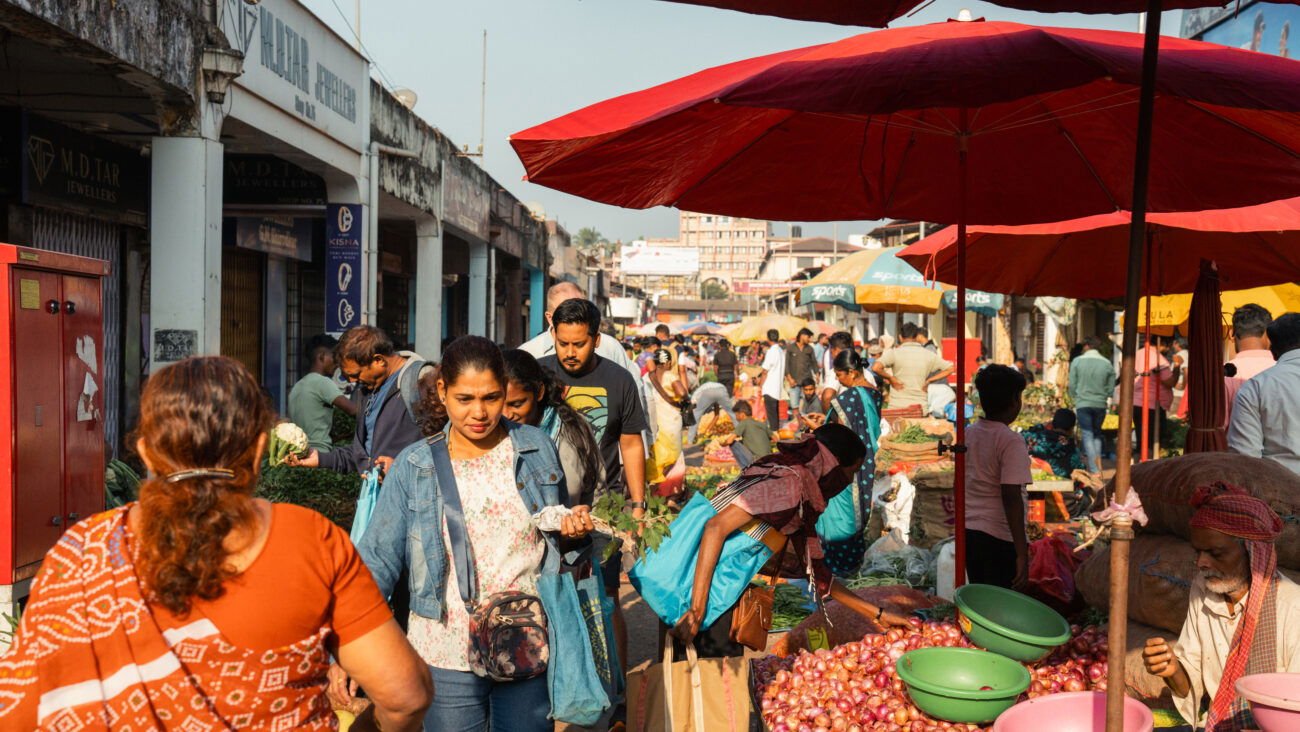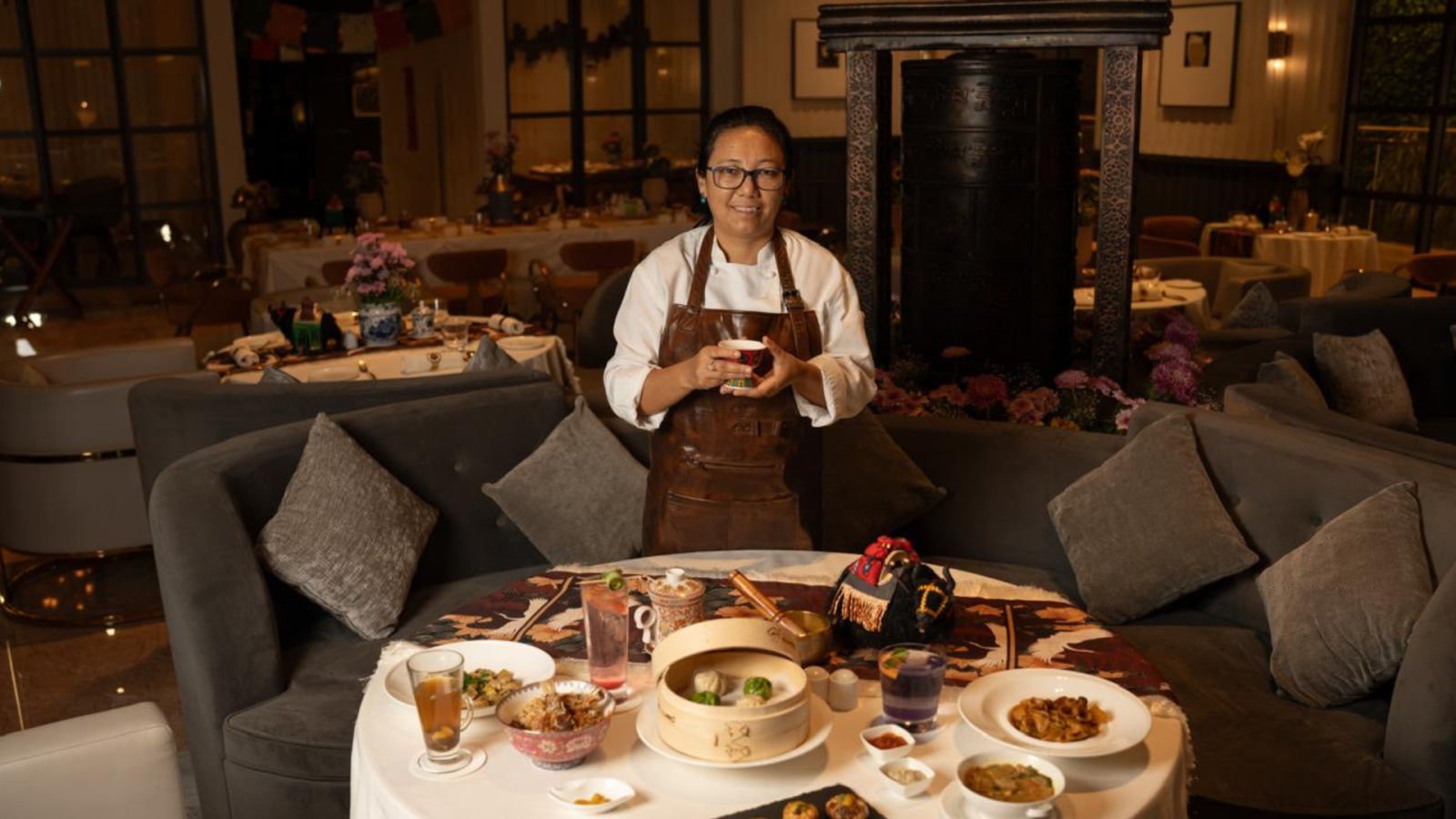Restaurants & Food
What To Eat And See On Your Next Visit To Florence, Italy

Aerial view of Florence from Piazza Michelangelo
Renowned for its rich history and stunning architecture, Florence is a must-visit destination for art enthusiasts and history buffs alike. From Michelangelo’s David and the Duomo, one of the largest churches in the world with its famous Brunelleschi-designed dome, to fashion museums from Gucci and Ferragamo and fabulous Tuscan food (including gelato), Florence offers endless opportunities for exploration and discovery.
See And Do
Michelangelo’s David in Galleria dell’Accademia, Florence, Italy
After seeing the famous Duomo (free to enter), preferably early before the crowds descend, head to see Michelangelo’s David in the Accademia, 17 feet high and made from a single block of marble. And don’t miss the museum’s other considerable Renaissance treasures by Sandro Botticelli, Domenico Ghirlandaio and Filippino Lippi. It’s best to use a tour company for tickets as the queues are madness. A good one is Get Your Guide where you go in an organised, timed queue with a guide who also offers interesting commentary.
Anselm Kiefer’s “Falled Angels” at Palazzo Strozzi in Florence, Italy.
For contemporary art, Palazzo Strozzi is a must. The current show, Fallen Angels, is a tremendous exhibition in every meaning of the word (the works are massive) by Anselm Kiefer. The Renaissance architecture of Palazzo Strozzi provides an excellent backdrop for new and historical works by the German artist, including a new commission created for the palace’s internal courtyard, free for everyone to view. And if you’re at the Strozzi, do see the painting exhibition nearby at Hotel Savoy. Abstract Perspectives: Annya Sand’s Tribute To Women runs until 20 May 2024 in the hotel’s public spaces.
The Giunti Odeon Libreria e Cinema in Florence, Italy.
For a break to contemplate the range of art and history that surrounds you in Florence, another beautiful historic building in the center offers respite. The Odeon cinema is in a Renaissance palace with a bookshop downstairs and 200 plush armchairs in the mezzanine gallery above to relax in. There’s also a big screen showing free films in the afternoon.
One section of the handbag room at the Gucci museum, Florence
Essential for fashionistas is the Gucci Visions exhibition inside the 14th-century Palazzo della Mercanzia on the lovely Piazza Signoria. The newly designed interior features a store with one-of-a-kind items, a restaurant and the Gucci Garden Galleria exhibition rooms upstairs that draw on Gucci’s extensive archives including old advertising campaigns, artisans’ images, objects and garments. Expect to be wowed by the beautifully displayed vintage dresses, shoes and luggage. There’s even one incredible room with just handbags. A petite, red-velvet tented cinema auditorium, shows artist films with the general theme of beauty.
Ferragamo Museum, Florence
For a deep dive into the life and work of Tuscan fashion designer Salvatore Ferragamo, Museo Ferragamo provides a fascinating look at the incredible rise of a designer who came from extremely humble roots to become shoemaker to the stars. The exhibition details his early life and immigration to America, his first store in Hollywood in 1923 and his return to Florence where everything is made today. Ferragamo’s creations are presented not only to highlight their value as works of art but to show their creator’s skills as an entrepreneur and innovator, his passion for color and knowledge of the anatomy of the human skeleton and specifically the foot. The exhibition shows his exploration of new materials and the many sources of inspiration from the art world and ancient and contemporary culture.
View of the Tuscan hills just outside of Florence at Podere Castellare
For an afternoon excursion or even a stay, just outside of Florence, head to the glorious Tuscan hills to visit Podere Castellare, an agriturismo with 12 boutique guest rooms, restaurant and a pool. The Podere also houses a micro gin distillery, Peter in Florence which offers daily tours. Peter in Florence is a London dry gin, created where the world’s best juniper grows. The gin is a carefully crafted blend of 14 botanicals, including the Iris flower, a symbol of the city of Florence. Book a distillery tour to see how the gin is distilled in a modern designed version of the classic 1831 Carter Head still, using 100% natural botanicals and ingredients.
Peter of Florence Gin Distillery at Podere Castellare
The tour includes a stroll through the gardens to see the botanicals used in the gin, mostly all grown on site, followed by a tasting of the various gins including London Dry, a stronger Navy gin, a limited edition that includes chamomile and saffron, and bottled negroni and martini cocktails. Peter in Tuscany gin is only a few years old but is already served in all fine bars and restaurants in Florence and just won best gin of the year in the global Bartender Spirits Awards.
Eat and Drink
Part of the tasting menu at Nugolo, Florence
It’s no surprise that Nugolo was featured in Stanley Tucci’s CNN series, Searching for Italy because what a delight it is, from its rustic Tuscan farmhouse decor and design with an open-view kitchen, to the stellar menu. The restaurant was founded by Nerina Martinelli, who is keen to preserve the different varieties of produce that are slowly disappearing. Her creative young chefs use seasonal and local ingredients to create imaginative dishes like Agnolotti di ossobuco and Fusilloni infused with black tea from juniper and rabbit ragu. Tasting menus are excellent and good value at 60 euros for five courses or 80 euros for seven.
Il Paglio, Four Seasons Florence
For the ultimate Florentine fine dining experience, Il Palagio at Four Seasons Hotel is incredible in both its setting, on the ground floor of the Palazzo della Gherardesca, surrounded by extensive mature garden and its gourmet menu. The Michelin-starred restaurant offers a la carte or a five or eight course tasting menu. The cuisine focuses on Italian culinary traditions reinterpreted by chef Paolo Lavezzini, who describes himself as “Italian by heart and Brazilian by soul” (he spent many years working in Brazil). Although born in the region of Emilia, Lavezzini’s dishes are Tuscan focused with the occasional Brazilian influence. Highlights include red potato gnocchi with seafood, grilled lobster glazed with hazelnuts and cockerel agnolotti with mushrooms. Vegetarians are also well catered for, with their own tasting menu.
Irene at Hotel Savoy features a satisfying mediterranean menu with delicious pasta dishes including long rectangular lasagna. Best known for his two Michelin-starred restaurant Gambero Rosso in San Vincenzo, Fulvio Pierangelini has worked with head chef Giovanni Cosmai and Florence’s best, local suppliers to create a menu based on the Tuscan classics.
For a casual breakfast, lunch or dinner, the bistro Ditta Artigianale is a top choice. Founded in 2013 by Patrick Hoffer and Francesco Sanapo, world-renowned barista and coffee taster champion, the bistro is now in four locations. Satisfying and filling, the menu includes hearty choices like club sandwich, caesar salad and croque monsieur. They also have incredible pastries and breads provided by their onsite bakery. Try the square tiramisu croissant with one of the best cups of coffee in the city.
Meze at the Calimala
Mezè at Calimala hotel features Mediterranean cuisine using typical Tuscan flavors, Sashimi, homemade bread and house dips, a 12 year old balsamic from Modena, spicy red pepper spread, green pepper and spicy herb spread, steak on a skewer and beef tartare are all delicious.
Angel Bar at the Calimala
Angel Roofbar on the rooftop of the Hotel Calimala is spread over four terraces and is one of the city’s most popular bars. It also serves as a breakfast area for hotel guests.
Loggia Roof Bar, overlooking Piazza Santo Spirito square in Hotel Palazzo Guadagni, offers expansive views of the city and its surrounding hills and is the ideal place for an aperitivo.
Rifrullo, in the funky San Niccolò area on other side of the river, has been going since 1917. Located in the neighborhood historically known for artists and creative thinkers, Rifrullo Firenze is a great place for cocktails or coffee.
Also in the San Niccolò area is the excellent Zeb, run by the same family since 1985. Sit at the counter and enjoy delicious Tuscan food and fantastic handmade pasta, carefully prepared by Alberto and his small team. After dining, take a stroll to the lovely rose garden a few streets above, with views of the Arno river.
Mercato Centrale, Florence
Dating back to the nineteenth century and open daily from 9 a.m. to 12:00 a.m. Mercato Centrale is a huge fresh food market over two floors, frequented by both locals and tourists, with plenty of tasty Italian dining options too.
It is said that the first in the world to produce real ice cream were the Florentines in the 16th century. Gelato Badiani isn’t that old but it’s been serving some of the city’s best gelato since 1932.
Where to Stay
A suite at Calimala, Florence
Hotel Calimala, a hip four star that opened recently in the center of the old town, is arranged over two historic buildings. Accommodation includes 38 rooms in the east building and 65 in the west of which 4 are suites. The rooms are spacious and comfortable, with high ceilings and some have balconies. Decor is contemporary: exposed stone and tricolor terrazzo floors, modern furnishings and marble finishes. A double room starts from 300 euros in low season, 450€ in high season.
Hotel Savoy façade, Florence
Hotel Savoy a five star Roccoforte property, was designed by Olga Polizzi and Laudomia Pucci (daughter of legendary fashion designer Emilio). The interior shows off Florence’s fashion heritage and its history, with signature prints, shoe motifs and antiques. There are 80 elegant rooms, including 30 suites, some with balconies, each with chic carrara marble and mosaic bathrooms. The excellent Irene restaurant serves breakfast, lunch and dinner. Double rooms start from 720 euros/night in low season.
Another luxury choice in the historic center, is Hotel Helvetia and Bristol, part of the Starhotels group. Since the late 19th century, this sumptuous hotel, with 64 bedrooms and suites, has been offering travelers refined accommodation and excellent service.
The gardens at Four Seasons, Florence
Just outside of the busy center is the Four Seasons, an oasis of calm, located in Florence’s biggest private garden with statues, fountains and contemporary sculptures. The hotel, housed in the magnificent Renaissance Palazzo della Gherardesca, formerly a Medici property, has 116 individually decorated bedrooms with lovely antiques, pictures, silks, velvets and brocades.
Getting there
British Airways offers daily direct flights to Florence from London Heathrow, Gatwick and London City.
Restaurants & Food
The Best Indian Restaurants in Houston

India’s serves the usual tikka masala as well as specialties like chicken Ceylon and Goan fish curry.
The breadth and depth of Houston’s Indian food scene is hard to beat. The city offers exceptional choices for traditional North Indian cuisine, as well as restaurants specializing in South and West Indian dishes, high-end and playful fusions, and dessert shops and breakfast spots. From the seafood dishes of Goa to the menu options from recently opened Kitchen Rumors, here’s a guide to the best Indian restaurants in Houston.
Houstonia has updated this map to include the recently opened restaurant Kitchen Rumors.
“>
The India’s Restaurant buffet has been a Houston staple since the 1980s.
Restaurants & Food
How to Build a Grassroots Food Movement in India

As chef of the iconic Bombay Canteen, Thomas Zacharias helped ignite fresh interest in local ingredients and lost food traditions. Now, through his fast-growing Local Food Club, he’s building something far more ambitious.
Thomas Zacharias, better known in India as Chef Zac, has cooked in some of the world’s top kitchens. After an educative but bruising stint in the upper echelons of New York fine dining, he returned to India to open the iconic Bombay Canteen, where he helped spark a movement in the country around local ingredients and forgotten food traditions. But he found his true calling as a storyteller, first through his popular “Chef on the Road” video series, then through his platform The Locavore, which he founded in 2021 after leaving the restaurant world to highlight sustainable food practices (he also put together our first League of Travelers journey to India). With his latest endeavor Local Food Club, Chef Zac is bringing these conversations off the page and into communities across the country.
Charly Wilder: Did you always know you wanted to be a chef?
Chef Zac: I grew up in Kerala, and I spent a lot of time in my grandmother’s kitchen. Both my parents worked full-time, so afternoons, weekends and summer holidays were spent with her. She was a very experimental cook. In retrospect, she cooked locally and seasonally—just as a way of life.
Back in the ’90s in India, there was no concept of celebrity chefs. I didn’t even know being a chef was a real profession until I was about 15 or 16. Once I knew, I was sure. I studied hotel management in India—because back then, we didn’t have culinary schools—and then I went to the Culinary Institute of America in New York.
After graduating, I applied to a few of the top restaurants I admired. One of them was Le Bernardin. I’d read On the Line, Eric Ripert’s book about how the kitchen worked, and I was obsessed. But when I got there, it was awful. I was severely bullied by a senior cook.
Charly Wilder: Have you watched The Bear?
Chef Zac: It was exactly like The Bear. That first season? That’s literally what I went through—every day.
Charly Wilder: Insane that shit goes on still.
Chef Zac: I think it’s less now. This was more than 15 years ago, and I’ve seen people being fired for things like that in recent years. But back then it was bad. And because I was on a student visa, I was too scared to speak up. I didn’t know what would happen to my immigration status. So I just waited out my visa and left.That experience made it clear: if I ever had my own kitchen, it would be the opposite of that.
Charly Wilder: So you moved back to India?
Chef Zac: Yeah. I started working at Olive in Mumbai, a modern Mediterranean restaurant, and after a few years, I took a sabbatical to travel through Europe. But then I realized: I had spent all my savings exploring foreign cuisines, and I’d done nothing to explore my own. So at that point I decided to make an 180 degree shift and started focusing on Indian food.
Serendipitously this was the exact time that the people behind Bombay Canteen were looking for a chef. So I joined in 2014, but I still knew very little about Indian cuisine. I realized that I couldn’t really learn from any texts or cookbooks because we didn’t have reliable ones in India. The only way for me to learn about regional cuisine was to travel.
Charly Wilder: So this is how “Chef on the Road” started?
Chef Zac: Yes, I started documenting my travels through the prism of a curious, exploratory chef, very inspired by Bourdain. I did a food road trip across 18 regions in India. I found recipes, techniques, stories, and ingredients I’d never seen before—stuff that wasn’t in any cookbook, wasn’t being taught, wasn’t on restaurant menus. What I saw and experienced blew my mind.
Charly Wilder: Can you give an example?
Chef Zac: I remember going just 50 miles outside Mumbai and meeting native tribal communities who were still foraging and cooking with ingredients passed down for generations—plants and herbs that nobody in the city had even heard of. I like to ask people: how many of you know avocado? Everyone raises their hand. Then I say: how many of you know shevla? Nobody does. But shevla grows right here, just outside the city. That moment really stuck with me.
The long-term dream is a Local Food Club in every neighborhood in India.
Charly Wilder: And you translated this to the table at Bombay Canteen?
Chef Zac: Yes, that was the point where I found a stronger sense of purpose and we made it our mission to bring these regional foods and stories to the forefront. We were the only restaurant in the country doing that at the time. It got national attention. Awards. But I was still traveling, going to farms and villages, and I realized: we’re losing so much. So many traditions. So much biodiversity. And meanwhile, in the restaurant, I felt more and more disconnected from the impact I actually wanted to make. So after seven years, I decided to leave, and start The Locavore. I didn’t want to just be a chef—I wanted to build a platform that could champion the people doing the real work on the ground and connect them to the people who never get to hear their stories.
Charly Wilder: How do you describe The Locavore to people unfamiliar with it?
Chef Zac: In a nutshell, The Locavore is a platform that champions local food and sustainability across India through storytelling, through events and social impact projects, and through partnering with farmers and grassroots organizations. In a sense, it’s a lot of businesses in one, working across themes and geographies.
Charly Wilder: The stories you tell are so deeply reported and locally focused….
Chef Zac: Yes, we’re only putting out 8-10 stories a month, but when we tell a story, for instance, of a producer, we talk about why we love them and then we break down their practices: what they’re doing with traditional knowledge, how they’re packaging their products, what’s in their products, how they compensate and treat their workforce. Are they organic? What are they doing with the community? And then we lead readers to products they can buy to close the loop.
Charly Wilder: Let’s talk about the Local Food Club. What is it, and how did it come to be?
Chef Zac: From the beginning with The Locavore, we wanted to create more than just a storytelling platform or an impact consultancy. We realized there aren’t many spaces around food where people feel like they truly belong—especially those who care about sustainability, culture, community. We used to do one-off events around the country, and every time, people would say, “We love this. We found our people. We want to do more. But you’re going to leave now—and what happens here?” That kept happening.
So I thought: what if we didn’t have to be there in person? What if we created a decentralized model where we are the hub, but the actual events are hosted by the community? That’s how the Local Food Club started. We provide the programming and structure—monthly themes, newsletters, conversation prompts. But the events themselves are hosted by volunteers. Restaurants and cafés offer their spaces for free. And every first Sunday of the month, from 4 to 7 p.m., the potlucks happen all over the country.
Charly Wilder: How big is it now?
Chef Zac: We started in May in six cities. In August, we’ll be in 23 locations. We already have 3,000 members and 26 WhatsApp groups. It’s kind of wild. Even in big cities like Mumbai, where we have more than 500 members, we cap each potluck at 35 people to keep it intimate. So now Mumbai has five different neighborhood potlucks each month.
Charly Wilder: So what does a typical Food Club gathering look like?
Chef Zac: People arrive and while they’re waiting, we usually have something fun—like a whiteboard where they draw themselves as a food or ingredient. Then we do what we call the Locavore Shuffle—it’s basically speed dating with food questions. People sit opposite each other and rotate every five minutes, using prompts about food memory, anthropology, culture. It completely transforms the room—strangers become friends.
We follow that with a group activity around the theme of the month. Last month it was Monsoon Sharing Circle—people talked about monsoon memories, what the season means to them, the ingredients they grew up with, seasonal dishes in their families. And then we do a potluck sharing circle. You don’t have to bring a dish—you can bring a hyperlocal ingredient, a family utensil, or a food story. Everyone shares, and then we eat together.
Charly Wilder: What do people actually cook and bring?
Chef Zac: We nudge people to think seasonally and locally. Like during monsoon season, we encourage people to cook with monsoon vegetables or use ingredients their grandparents used. Some folks are already cooking that way, others are learning from each other.
We’re not rigid, though. Someone brought chocolate chip cookies—but with flour from native wheat and chocolate sourced from a single-origin Indian cacao grower. It’s all about intention. Recently I was in Jaipur and corn was in season. There were a couple of corn dishes, some amazing fritters, and a dish called arbi ki kachri—which I’d never tasted before.
Charly Wilder: Is the idea just to gather and eat, or do the clubs take on bigger projects?
Chef Zac: Right now the focus is on gathering—creating space, building trust, making it fun. But over time, each club can start taking on local projects. One might document traditional markets. Another might start a composting initiative. Another might revive a lost recipe tradition. Eventually we want Local Food Clubs in villages, too—not just cities. We’re already piloting this with grassroots organizations in rural areas. The long-term dream is a Local Food Club in every neighborhood in India. We don’t want to dictate what each club does. You might as well lean into what people are excited about—and then we help champion that.
Charly Wilder: What ingredient did you draw yourself as on the whiteboard?
Chef Zac: Jamun. It’s a monsoon berry—really purple, really local. It’s unique, it’s versatile. I like that it leaves a mark. It makes your tongue purple. I like to think I leave an impact.
For more information on how to visit India with Chef Zac and the League of Travelers, visit our trip page: The Other Side of Goa
Restaurants & Food
India’s Tribal Cuisines Setting Global Trends

Foraging is a prominent culinary trend in the global dining scene. While it’s incredible to experience hyper-local produce at award-winning restaurants worldwide, it’s vital to remember that foraging has been integral to indigenous cuisines in almost all tribal communities of India for centuries. From Meghalaya and Assam in the Northeast to the rugged landscape of Ladakh and the forests of Jharkhand, communities have thrived due to their deep connection to seasons, forests, and locally available resources. Similarly, culinary buzzwords like ‘sustainability’ and ‘zero-waste cooking’ have been inherent practices in these communities for generations.
Today, highly trained international chefs discuss plant-based foods, local and seasonal produce, and nose-to-tail cooking. However, these have been inherent aspects of traditional cooking even in India’s most remote parts. We spoke to four champions promoting their regional cuisine, documenting it, educating others, and conducting restaurant pop-ups, to highlight indigenous ingredients, special dishes, and cooking techniques passed down through generations.
Revival Of The Forgotten Flavors Of Jharkhand
Jharkhand is home to 32 tribal communities, each with its own distinct food culture. “I’ve been able to document eight of these so far, but that’s just scratching the surface,” says Dr. Manisha Oraon. Not a typical food entrepreneur, Dr. Oraon is a dentist working in rural health, but her true passion lies in preserving Jharkhand’s tribal cuisines, long overshadowed and undocumented. Over the past six years, she has been on a personal mission to document, revive, and innovate upon the indigenous culinary traditions of her homeland. Her work stems from a growing concern of “forgotten identity,” as the traditional foods of Jharkhand—many of which are deeply sustainable and foraged from the forests—are disappearing from everyday lives, surviving only during ceremonies or festivals.
“When I went to the only restaurant in Ranchi that offers tribal food—Ajam Emba—I noticed that it served only the most basic dishes. None of the nuanced, seasonal, or ceremonial preparations were represented,” she laments. Another problem she notes is that people often equate Jharkhand’s food with dhuska or litti chokha, dishes that actually have their roots in the neighbouring state of Bihar. “Our food has a distinct identity that deserves recognition,” she states.
At the heart of traditional Jharkhandi meals is ‘maar jhor’, a staple across tribes in which the broth of an indigenous fibrous, low-glycemic brown rice is used to cook foraged greens. “We never had much access to pulses, so maar jhor became an important source of nutrition,” she explains. Meals also include chutneys, often made from bamboo shoots fermented in stages depending on the season and known locally as sandhana, and mashed preparations like chokha made from roasted tubers. Jharkhand’s cuisine also incorporates edible flowers found in forests, like roselle, kudrum, sania, and hemp flowers that are used in chutneys or added into the maar jhor. The culinary calendar is also in sync with the agricultural and religious one: “We worship trees, and through them, we honour the land and the food it gives us.”
Among the most underappreciated ingredients is mahua, a flower widely misunderstood as being used solely for making local liquor. “That stereotype of villages being alcoholic because of mahua is not only incorrect—it’s damaging,” she says. In reality, mahua has a wide range of uses. “Women eat three soaked mahua flowers in the morning to treat anaemia. We also dry them and use them as natural sweeteners or make them into candies and desserts,” explains Dr. Oraon. In one fascinating preparation, mahua flowers are slow-boiled for hours with roasted tamarind seeds and husk, forming a jaggery-like consistency used as a sweetmeat called mawa latha. “It’s what our people ate when there was nothing else. It was our dessert, a traditional treat,” she smiles. Mahua’s potential also extends to pharmaceuticals and cosmetics, with its seeds yielding oil used for burns and rashes, known locally as dori tel, akin to global shea butter.
Talking about global food trends, Dr. Oraon states that in many ways, Jharkhand’s food system has always been ahead of the curve. It champions nose-to-tail eating, fermentation, slow cooking, and zero-waste practices. It thrives on plant-based biodiversity, incorporates ancient grains like millets, and promotes climate-resilient crops. “We’ve been eating local, foraging, and preserving through sun-drying for generations—what the world is only now calling sustainable,” she says. With innovations like solar dehydrators, her farmer collective is now exploring ways to preserve ingredients more effectively while maintaining nutritional integrity. “We’re trying to combine traditional knowledge with modern techniques to protect what we have,” she says nonchalantly.
Meghalaya’s Tribal Dishes Find Space On Gourmet Tables
As the founder of Tribal Gourmet, A Northeast Indian Pop Up Kitchen, Tanisha Phanbuh’s mission is clear: not just to introduce people to the food of Meghalaya, but to change the way we think about indigenous cuisines from Northeast India. Based in Delhi but rooted in her Khasi heritage, she champions the region’s rich culinary diversity and deep traditions through pop-up kitchens and storytelling that highlight the nuances often overlooked in broader narratives.
“People tend to group all Northeast cuisines into one box,” she says, “but each state—and within them, each tribe—has distinct food traditions shaped by geography, history, and community.” In Meghalaya alone, the food of the Khasi, Jaintia, and Garo tribes varies not only in flavour but also in preparation. Khasi cuisine, for instance, is simple and straightforward, making it a great introduction for outsiders and first-time tasters, while Garo food reflects the state’s tropical climate, often using bolder, earthier ingredients.
A traditional meal in Meghalaya is based on steamed rice, accompanied by a variety of meat, greens, chutneys, and seasonal vegetables. “There’s an innate rhythm to how we eat,” Tanisha explains. “Summer meals are lighter—think stews with chicken or fish—while winters bring heartier fare, with pork, beef, and warming fermented bean pastes.” Interestingly, there’s a cultural preference to include bitter vegetables like bitter gourd or bitter eggplant at lunch, but not at dinner; such subtle dining rules have been passed down through generations.
What sets Meghalaya’s cuisine apart, especially for global audiences, is its deep reliance on hyperlocal and foraged ingredients. “Even in Delhi, I can access 40–50 unique ingredients each week from Northeast markets,” Tanisha says. Some standout elements include michinga, wild Sichuan pepper leaves prized for their heady aroma; tree tomatoes, tangier and meatier than conventional varieties; and sawtooth coriander, a sharper cousin of cilantro. Add to this an abundance of wild mushrooms, seasonal greens, and backyard herbs sourced from villages and forests, each telling a story of the land and the people who tend it.These traditional ingredients and methods are also remarkably in line with global food trends. “Fermentation, for example, is now seen as revolutionary,” she notes. “But we’ve been fermenting bamboo shoots, fish, and soybeans for generations.” Meghalaya’s respect for whole-animal cooking also mirrors the growing ‘nose-to-tail’ philosophy. Dishes like doh khlieh (pig brain salad) and ja doh (a pig’s blood in a risotto-like preparation) reflect not only ingenuity but a cultural reverence for resourcefulness and zero-waste cooking.
“In many ways, our food has been global before the world caught on,” Tanisha says with a smile. “I just wish more people knew about us, and that’s my lifelong goal.”
Ladakhi Cuisine Incorporates Warmth And Energy For The Harsh Climate
High in the trans-Himalayan region of Ladakh, the culinary tradition is deeply shaped by its geography, Buddhist culture, and the harsh yet beautiful climate of the mountains. Ladakhi cuisine is simple yet soul-nourishing with a strong focus on seasonality and sustainability. “Fermentation, drying, and sun-curing aren’t recent health fads here,” says Nilza Wangmo, founder of Alchi Kitchen, an all-women-run restaurant in Alchi. “They are time-honoured practices that our grandmothers taught us, methods that not only preserve food but also enhance its nutritional value, especially in a cold desert like Ladakh.”At its heart, Ladakhi food is an expression of resilience and harmony. Barley, the region’s staple grain, is transformed into dishes like phey or tsampa, while root vegetables, lentils, and wild greens are used in dishes that are as comforting as they are delicious. Even simple preparations like skyur, a fermented dough, or chhutagi, a hand-rolled pasta in a vegetable broth, reveal a delicate balance of texture and flavour. A typical Ladakhi meal is warm and filling, made with what is locally grown, especially essential in a place where winters are long and unforgiving. Flatbreads made from barley or wheat, broths such as thukpa, mokthuk, and chhanthuk, and generous helpings of mok mok (dumplings) make up daily meals. “Lunch might be a simple one-pot dish, but dinner is when the family gathers, especially in winter,” Nilza explains. Butter tea, locally known as gur gur cha, is consumed throughout the day offering both warmth and energy.
Local and foraged ingredients offer a rare insight into Ladakh’s biodiversity. Bright seabuckthorn berries (tsestalulu) bursting with Vitamin C, detoxifying nettles (zatsot), and the tangy native rhubarb (lachu) are not only delicious but also medicinal. Flavour enhancers like skotse (wild chives) and kornyot (wild cumin) deepen the sensory richness of Ladakhi food. These are ingredients that support immunity and well-being, principles now echoed in global wellness trends.
At Alchi Kitchen, the goal is clear: preserve the essence of Ladakhi cuisine while engaging in the global culinary conversation. “We’re deeply rooted in our traditions, but those traditions are now more relevant than ever,” says Nilza. “What the world is asking for—sustainability, plant-based diets, fermented foods, mindful eating—we’ve been doing for generations.” Their farm-to-table philosophy helps minimise food miles and maximise flavour by sourcing from local farms and foraging from the wild. But what sets Alchi Kitchen apart is its commitment to culinary storytelling. Every dish tells a story, that of a grandmother’s recipe, a family memory, or a harvest tradition. “In a fast-paced world, we offer a slow, immersive culinary experience that connects diners to the land, the people, and the past, mirroring the global trend toward experiential, mindful dining,” says Nilza.
The Simplicity, Sustainability, And Soul Of Assamese Home Food
For those who believe food tells the story of a place, Assamese cuisine offers a rich, deeply rooted narrative of heritage, ecology, and restraint. From foraged greens in forested villages to delicate fermentation techniques passed down through generations, Assamese food is a fine example of culinary subtlety and balance.
“As a food enthusiast with a passion for discovering indigenous cuisines, I find great joy in exploring the subtle nuances that define each culinary tradition. When it comes to my own Assamese cuisine, its uniqueness lies in the use of fresh, homegrown vegetables, a restrained yet thoughtful use of spices, and the emphasis on slow cooking techniques. These elements come together to create dishes that are not only deeply flavorful but also rooted in tradition and sustainability, making Assamese cuisine a true gem in the global gastronomic landscape,” says Parnashree Devi, a travel blogger who hails from Assam; she has been sharing the nuances of Assamese cuisine on various platforms.
Fresh, homegrown vegetables, seasonal herbs, and a nuanced use of spices are the cornerstones of this cuisine. Dishes are slow-cooked and designed to nourish. A traditional Assamese thali might feature the staple yellow daal, steamed rice, a mix of sautéed leafy greens (known locally as xaak), and simple but soulful sides like aloo pitika (mashed potatoes) or begun bhaja (fried eggplant). A more elaborate spread might include dishes like mati dail khar (a type of alkaline lentils), poita bhat (fermented rice), or kosuthuri kon bilahir logot, a rustic preparation of tender colocasia leaves with tangy cherry tomatoes. There’s also a wide variety of non-vegetarian fare such as lai xaak gahori (pork with mustard greens), til diya murgi (chicken with black sesame), and haah kumura (duck with ash gourd).
What makes Assamese cuisine so compelling on a global scale is its deep synergy with current culinary movements. “Farm-to-table cuisine is championed unequivocally as it’s a traditional way of life with the use of fresh herbs, wild greens, and locally sourced produce in daily cooking. Gut-friendly staples like fermented mustard seeds and poita bhat have been nourishing our people for centuries,” explains Parnashree. With its slow cooking methods, clean flavours, nutrient-dense dishes, and rich connection to land and heritage, Assamese cuisine is very much at par with global standards.
Related: Arunachal Pradesh Vs Assam — Which Northeast Indian Escape Is Right For You?
Note:
The information in this article is accurate as of the date of publication.
Written By
-

 Brand Stories2 days ago
Brand Stories2 days agoBloom Hotels: A Modern Vision of Hospitality Redefining Travel
-

 Brand Stories1 day ago
Brand Stories1 day agoOlive Living: India’s Intelligent, Community-Centric Hospitality Powerhouse
-

 Destinations & Things To Do3 days ago
Destinations & Things To Do3 days agoUntouched Destinations: Stunning Hidden Gems You Must Visit
-

 AI in Travel3 days ago
AI in Travel3 days agoAI Travel Revolution: Must-Have Guide to the Best Experience
-

 Brand Stories3 weeks ago
Brand Stories3 weeks agoVoice AI Startup ElevenLabs Plans to Add Hubs Around the World
-

 Brand Stories2 weeks ago
Brand Stories2 weeks agoHow Elon Musk’s rogue Grok chatbot became a cautionary AI tale
-

 Asia Travel Pulse3 weeks ago
Asia Travel Pulse3 weeks agoLooking For Adventure In Asia? Here Are 7 Epic Destinations You Need To Experience At Least Once – Zee News
-

 AI in Travel3 weeks ago
AI in Travel3 weeks ago‘Will AI take my job?’ A trip to a Beijing fortune-telling bar to see what lies ahead | China
-

 Brand Stories3 weeks ago
Brand Stories3 weeks agoChatGPT — the last of the great romantics
-

 The Travel Revolution of Our Era1 month ago
The Travel Revolution of Our Era1 month agoCheQin.ai Redefines Hotel Booking with Zero-Commission Model












